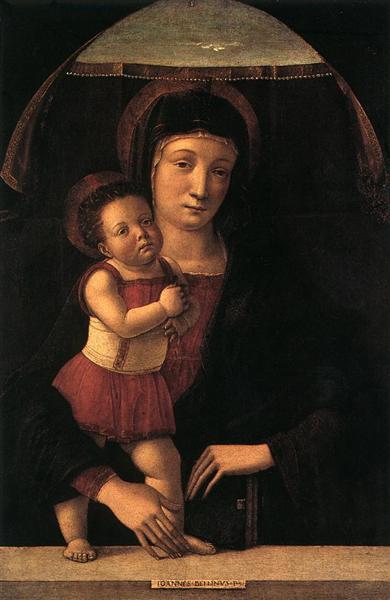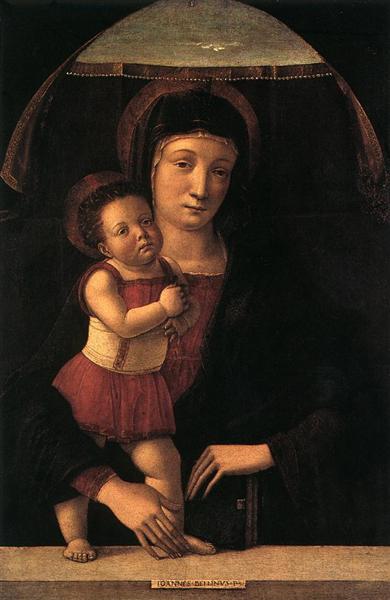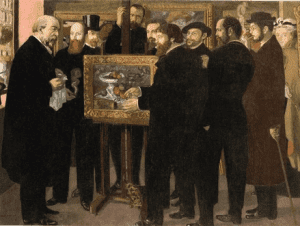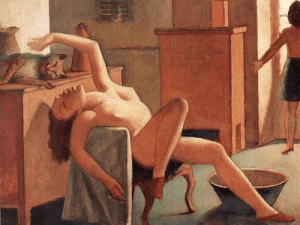In the rich tapestry of the Early Renaissance, Giovanni Bellini stands out as a Venetian master who infused religious art with a new level of human emotion and warmth. One of his early, powerful examples of this is the Madonna with Child, a tempera on wood panel painting created between 1450 and 1455.
This intimate and moving work, now housed in the Pinacoteca Malaspina in Pavia, Italy, showcases the young artist grappling with powerful influences while forging a unique style that would define Venetian painting for generations.

Madonna with Child by Giovanni Bellini
A Blend of Influences 
To appreciate this painting, we must understand the artistic world of mid-15th century Venice. As a young artist, Bellini was absorbing lessons from several key sources, all of which are visible in this work:
Byzantine Tradition: The general composition—a half-length Madonna and Child set against a dark, undefined background—is heavily based on traditional Byzantine icons that were revered in Venice. This gives the work a timeless, devotional quality.
Family and Local Masters: Bellini was deeply influenced by the workshop of his father, Jacopo Bellini, and the style of contemporary Venetian painters like Bartolomeo Vivarini.
Paduan Realism: The strong, almost sculptural lines used to define the Christ Child show the clear influence of the Paduan school, particularly the workshop of Francesco Squarcione. This adds a sense of tangible, physical presence to the figures.
Artistic Analysis: A Closer Look
Bellini takes these traditional elements and elevates them with a profound sense of humanity and tenderness.
The Intimate Connection
The focus of the painting is the deeply personal relationship between mother and son. The Madonna is not a distant, heavenly queen but a young mother with a gentle, slightly melancholic expression. She holds her child with a natural tenderness, her hands providing a secure and loving support. The Christ Child, while possessing a solemn wisdom, looks out with the inquisitive gaze of a real infant.
The Parapet and Signature
In the foreground, a marble parapet separates the divine figures from the viewer’s space. This was a common compositional device, but Bellini uses it to bring the scene closer to us. On the parapet, a small scroll, reminiscent of Flemish painting, bears the artist’s signature: IOANNES BELLINVS P. (Giovanni Bellini Painted This). By having the Christ Child himself seem to hold this scroll, Bellini cleverly integrates his own presence into the sacred scene.
A Masterpiece in the Making
While the exact dating is debated by scholars, the Pavia Madonna with Child is undoubtedly an early work. It demonstrates an artist on the cusp of greatness, skillfully blending the sharp lines of the Paduan school with the emerging Venetian focus on colour and emotion. This painting is closely related to a similar composition by Bellini now in Philadelphia, showing his exploration of this powerful theme.
It stands as a testament to Bellini’s ability to transform a traditional religious subject into a deeply moving portrayal of human love and divine mystery.
Key Facts at a Glance
Artist: Giovanni Bellini (c. 1430–1516)
Title: Madonna with Child
Date: circa 1450–1455
Style: Early Renaissance
Medium: Tempera on wood
Location: Pinacoteca Malaspina, Pavia, Italy
Visiting the Painting in Pavia
This remarkable piece is a highlight of the Pinacoteca Malaspina, part of the Civic Museums of Pavia. To experience the quiet power and subtle emotion of Bellini’s early work, a visit is highly recommended. Always be sure to check the museum’s official website for the latest visitor information and opening hours before your trip.








Responses